
Bruno Munari was "one of the greatest actors of 20th-century art, design and graphics". He was an Italian artist, designer, and inventor who contributed fundamentals to many fields of visual arts in modernism, futurism, and concrete art, and in non-visual arts with his research on games, didactic method, movement, tactile learning, kinesthetic learning, and creativity. On the utility of art, Munari once said, "Art shall not be separated from life: things that are good to look at, and bad to be used, should not exist".
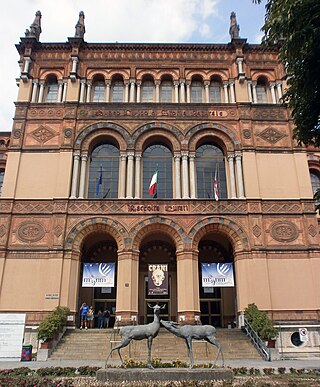
The Museo Civico di Storia Naturale di Milano is a museum in Milan, Italy. It was founded in 1838 when naturalist Giuseppe de Cristoforis donated his collections to the city. Its first director was Giorgio Jan.

The Museum of the Risorgimento, located in the 18th-century Milanese Palazzo Moriggia, houses a collection of objects and artworks which illustrate the history of Italian unification from Napoleon's first Italian campaign of 1796 to the annexation of Rome in 1870. The city of Milan played a key role in the process, most notably on the occasion of the 1848 uprising against the Austrians known as the Five Days of Milan.

Via Manzoni is a busy and fashionable street in the Italian city of Milan which leads from the Piazza della Scala north-west towards Piazza Cavour. Notable buildings include the Museo Poldi Pezzoli, the elegant Grand Hotel et de Milan, which was the place of Giuseppe Verdi’s death in 1901, and several fine palaces. Via Manzoni was originally called Corsia del Giardino before the crossroad with Via Monte Napoleone and Corso di Porta Nuova up until Piazza Cavour.

Corso Venezia is a street in Milan, Italy. It is one of the city's most exclusive and elegant avenues, being part of the city's upscale Quadrilatero della moda shopping district, along with Via Montenapoleone, Via della Spiga, Via Sant'Andrea and Via Manzoni. It also boasts a great collection of Renaissance, Baroque, Rococo and Neo-classical palaces, parks and gardens.

Calvairate is a district (quartiere) of Milan, Italy. It is part of the Zone 4 administrative division, located east of the city centre.

Bovisa is a district (quartiere) of Milan, Italy, located north of the city center, in the Zone 9. The name is supposedly derived from the Italian word bove, meaning ox, as the area developed from an ancient rural settlement.

The Zone 1 of Milan, since 2016 officially Municipality 1 of Milan, is one of the 9 administrative divisions of Milan, Italy.

Chiesa di Santa Maria al Paradiso is a church in Milan, Italy. It was begun in 1590 for the Third Order of Saint Francis, after designs by Martino Bassi. The facade, however, was only added in 1897 in a Neo-Baroque style by the architect Ernesto Pirovano (1866-1934).
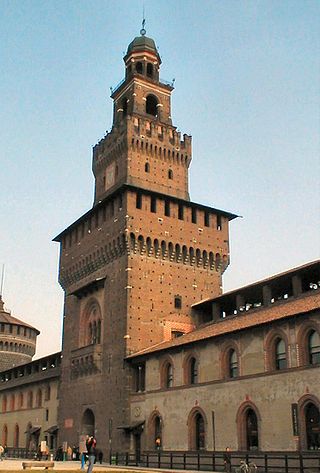
The Museo Egizio or Egyptian Museum is a museum sited in the Sforza Castle of Milan, Italy. The Castle is one of the most famous monuments in Milan and is home to several museums including the Egyptian Section of the Milan Archaeological Museum, the Museum of Ancient Art, the Pinacoteca and the Museum of Musical Instruments.
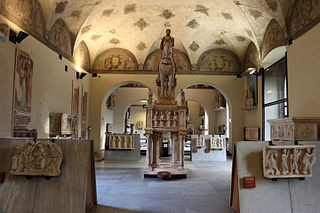
The Museo d'Arte Antica is an art museum in the Castello Sforzesco in Milan, in Lombardy in northern Italy. It has a large collection of sculpture from late antiquity and the medieval and Renaissance periods. The various frescoed rooms of the museum house an armoury, a tapestry room, some funerary monuments, Michelangelo's Rondanini Pietà and two medieval portals.

The Museo del Novecento is a museum of twentieth-century art in Milan, in Lombardy in northern Italy. It is housed in the Palazzo dell'Arengario, near Piazza del Duomo in the centre of the city.

The Museum of Musical Instruments of Milan exhibits over 700 musical instruments from the fifteenth to twentieth centuries with particular attention to Lombard instruments. The collection contains plucked instruments, Lombard and Cremonese violins, hunting horns, numerous wood instruments, bassoons, pianos and some ancient organs. In particular the Cremonese lutherie is appreciated all over the world for the high quality of its musical instruments. The museum also displays the equipment of the former Studio di fonologia musicale di Radio Milano.

The Pinacoteca del Castello Sforzesco is an art gallery in the museum complex of the Castello Sforzesco in Milan, northern Italy.

Casa Manzoni is a historical palace sited in via Morone 1 near the quadrilateral of fashion in the center of Milan, Italy. Owned by the Manzoni family, the house was the birthplace of the famous Italian writer Alessandro Manzoni in 1785.
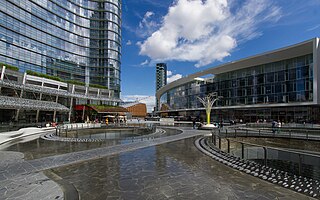
The Zone 9 of Milan, since 2016 officially Municipality 9 of Milan, is one of the 9 administrative divisions of Milan, Italy.
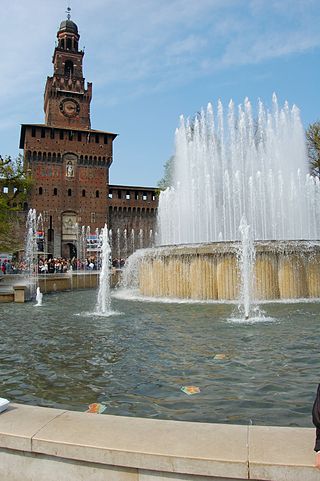
The Applied Arts Collection of Milan is located in the Sforza Castle museum complex under the management of the municipality of Milan, Italy. The museum is divided into several sections with particular emphasis on jewelry, ivories, pottery and art glass.

The Antique Furnishings & Wooden Sculpture Museum of Milan is located on the first floor of the Sforza Castle ducal courtyard and it is part of the Sforza Castle's Civic Museum complex.

The Diocesan museum of Brescia is a museum in Italy dedicated to the artistic patrimony of the Diocese of Brescia, and is located in the greater cloister of the Monastery of Saint Joseph in via Gasparo Salò, a short distance from the Piazza della Loggia.

The Albino Luciani Diocesan Museum is a museum of Christian art in the Ceneda district of Vittorio Veneto in northern Italy, located on the top floor of the episcopal seminary in the piazza Giovanni Paolo I.





















